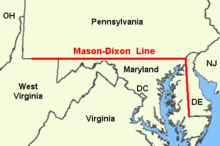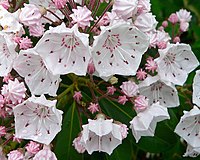Portal:Pennsylvania
The Pennsylvania Portal Pennsylvania (/ˌpɛnsɪlˈveɪniə/ ⓘ, lit. 'Penn's forest country'), officially the Commonwealth of Pennsylvania (Pennsylvania Dutch: Pennsylvanie), is a state spanning the Mid-Atlantic, Northeastern, Appalachian, and Great Lakes regions of the United States. Pennsylvania borders Delaware to its southeast, Maryland to its south, West Virginia to its southwest, Ohio and the Ohio River to its west, Lake Erie and New York to its north, the Delaware River and New Jersey to its east, and the Canadian province of Ontario to its northwest. Pennsylvania was founded in 1681 through a royal land grant to William Penn, the son of the state's namesake. Prior to that, between 1638 and 1655, a southeast portion of the state was part of New Sweden, a Swedish Empire colony. Established as a haven for religious and political tolerance, the colonial-era Province of Pennsylvania was known for its relatively peaceful relations with native tribes, innovative government system, and religious pluralism. Pennsylvania played a vital and historic role in the American Revolution and the ultimately successful quest for independence from the British Empire, hosting the First and Second Continental Congress leading to the adoption of the Declaration of Independence. On December 12, 1787, Pennsylvania became the second state to ratify the U.S. Constitution. The bloodiest battle of the American Civil War, at Gettysburg over three days in July 1863, proved the war's turning point, leading to the Union's preservation. Throughout the late 19th and 20th centuries, the state's manufacturing-based economy contributed to the development of much of the nation's early infrastructure, including key bridges, skyscrapers, and military hardware used in U.S.-led victories in World War I, World War II, and the Cold War. Pennsylvania's geography is highly diverse. The Appalachian Mountains run through the center of the state; the Allegheny and Pocono mountains span much of Northeastern Pennsylvania; close to 60% of the state is forested. While it has only 140 miles (225 km) of waterfront along Lake Erie and the Delaware River, Pennsylvania has the most navigable rivers of any state in the nation, including the Allegheny, Delaware, Genesee, Ohio, Schuylkill, Susquehanna, and others. (Full article...) This is a Featured article, which represents some of the best content on English Wikipedia..
Idlewild and Soak Zone, commonly known as Idlewild Park or simply Idlewild, is an amusement park in the Laurel Highlands near Ligonier, Pennsylvania, United States, about 50 miles (80 km) east of Pittsburgh, along US Route 30. Founded in 1878 as a campground along the Ligonier Valley Railroad by Thomas Mellon, Idlewild is the oldest amusement park in Pennsylvania and the third oldest operating amusement park in the United States behind Lake Compounce and Cedar Point. The park has won several awards, including from industry publication Amusement Today as the best children's park in the world. The prominent Mellon family established the park in 1878, and it remained family-owned for over 100 years. It expanded greatly throughout the first half of the 20th century, adding rides including a Philadelphia Toboggan Company Rollo Coaster in 1938, one of the company's earliest. The park is home to the Ligonier Highland Games, a Scottish athletic and cultural festival that has annually drawn over 10,000 spectators. In 1983, the park was purchased by Kennywood Entertainment Company, which oversaw additional expansion, including an attraction designed and voiced by Fred Rogers based on his television show Mister Rogers' Neighborhood. Since 2008, the park, as well as others formerly under Kennywood Entertainment, have been owned by Spanish company Parques Reunidos and operated by their American subsidiary Palace Entertainment. (Full article...)Selected geography article -Allentown (Pennsylvania Dutch: Allenschteddel, Allenschtadt, or Ellsdaun) is a city in Pennsylvania and the county seat of Lehigh County, Pennsylvania, United States. It is the third-most-populous city in Pennsylvania with a population of 125,845 as of the 2020 census and the most populous city in the Lehigh Valley metropolitan area, which had a population of 861,899 and was the 68th-most populous metropolitan area in the nation as of 2020. Founded in 1762, Allentown is located on the Lehigh River, a 109-mile-long (175 km) tributary of the Delaware River. It is the largest of three adjacent cities, including Bethlehem and Easton in Lehigh and Northampton counties, in the Lehigh Valley region of eastern Pennsylvania. Allentown is located 48 miles (77 km) north of Philadelphia and 78 miles (126 km) west of New York City. (Full article...)Selected image -Did you know -
Related portalsWikiprojectsThis is a Good article, an article that meets a core set of high editorial standards.
The Appalachian Trail, also called the A.T., is a hiking trail in the Eastern United States, extending almost 2,200 miles (3,540 km) between Springer Mountain in Georgia and Mount Katahdin in Maine, and passing through 14 states. The Appalachian Trail Conservancy claims the Appalachian Trail to be the longest hiking-only trail in the world. More than three million people hike segments of the trail each year. The trail was first proposed in 1921 and completed in 1937. Improvements and changes have continued since then. It became the Appalachian National Scenic Trail under the National Trails System Act of 1968. (Full article...)Selected article - The Mason–Dixon line, also called the Mason and Dixon line or Mason's and Dixon's line, is a demarcation line separating four U.S. states, constituting parts of the borders of Pennsylvania, Maryland, Delaware, and West Virginia (part of Virginia until 1863). It was surveyed between 1763 and 1767 by Charles Mason and Jeremiah Dixon as part of the resolution of a border dispute involving Maryland, Pennsylvania, and Delaware in the colonial United States. The dispute had its origins almost a century earlier in the somewhat confusing proprietary grants by King Charles I to Lord Baltimore (Maryland), and by his son King Charles II to William Penn (Pennsylvania and Delaware). The largest portion of the Mason–Dixon line, along the southern Pennsylvania border, later became informally known as the boundary between the Southern slave states and Northern free states. This usage came to prominence during the debate around the Missouri Compromise of 1820, when drawing boundaries between slave and free territory was an issue, and resurfaced during the American Civil War, with border states also coming into play. The Confederate States of America claimed the Virginia portion of the line as part of its northern border, although it never exercised meaningful control that far north – especially after West Virginia separated from Virginia and joined the Union as a separate state in 1863. It is still used today in the figurative sense of a line that separates the Northeast and South culturally, politically, and socially . (Full article...)Pennsylvania news
CategoriesState factsState Facts
State symbols
Pennsylvania topicsGeneral imagesThe following are images from various Pennsylvania-related articles on Wikipedia.
Associated WikimediaThe following Wikimedia Foundation sister projects provide more on this subject:
Discover Wikipedia using portals |


































































